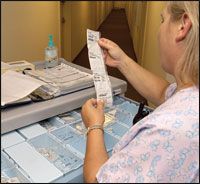Publication
Article
Pharmacy Times
feature: onePAC Innovates Drug Dispensing on Long-term Care
Author(s):
onePAC compliance packaging helps reduce medical errors and drive adherence.

The use of the punch card andpaper cups to dispense medicationsare no longer consideredthe norm in long-term care settings.Parata Systems PACMED onePAC compliancepackaging offers health carefacilities a convenient and safer alternativein medication delivery.
Currently, 10,000 beds in US long-termcare facilities use the packaging system,said Meredith Sweeney, product managerfor PACMED. Assisted living, skillednursing, and group homes are examplesof extended-care settings that are underthe umbrella of long-term care.
"It makes obvious sense for long-termcare because it allows you to be morecompliant with drug regimens," said TomRhoads, executive vice president for customerand market strategies at Parata.The company acquired the US rights tosell PACMED in 2006 as part of its acquisitionof McKesson APS.
Medication compliance is an issue cliniciansface daily in the United States. Dataindicate that noncompliance is the thirdleading cause of preventable death, comprises10% of hospital admissions and30% of assisted living and nursing homeadmissions, and costs an estimated $100billion in annual health care costs.
OnePAC compliance packaging is personalizedby the patient. Each unit- ormultidose package contains all the informationneeded to ensure the right patientreceives the right medications at the righttime. The package can be customizedwith up to 19 lines that may include thepatient name, drug name/strength/description, and time of dose. Sweeneysaid that the 1 pack can fit 5 to 7 pills,depending on the pill size.
The advantages of the onePAC compliancepackaging, operated by Server Plussoftware, include on-time medication-passcycles, reduced medication-passtimes, increased time for patient care,and reduced medication errors. Sweeneysaid feedback from the clinicians usingonePAC has been "amazing." "They [clinicians]like it from the perspective that it'seasy, especially in a group home."

Kelley-Ross Long Term Care Pharmacyhas seen its benefits since it began usingPACMED in May 2006. The pharmacy is1 of 5 pharmacies that are part of Kelley-Ross & Associates. The company alsooperates 3 community/clinic-based pharmaciesand a mail-service pharmacy.
Serving about 50 facilities in the greaterSeattle, Washington area, the pharmacyfills approximately 9000 prescriptions onaverage per month. The system was chosen"due to the integration with our pharmacymanagement system and thepotential for end-to-end integration withour facilities electronic medical recordsand dispensing systems," explained BrianBeach, PharmD, FACA, director of long-termcare services.
The user-friendly system has allowedthe pharmacy to "offer unit- and multi-dosepackaging to our facilities thatworks well with weekly, biweekly, andmonthly cycle fills. It also has providedfull compliance with regulations throughexact labeling and identification of eachdose," said Dr. Beach.
A benefit of theonePAC is that ithas allowed thepharmacy andfacility to ensurethat eachpatient gets the5 rights of medication."This isdone throughdecreasing errorrates by automatingsome ofthe repetitive tasks that are done in thepharmacy such as product selectionand filling of selected packaging," hesaid.
Dr. Beach also added that being able tomanage each prescription at the doselevel is crucial for long-term care. "Withthe potential turnover of patients andchanges in medications, it is very importantto have direct control over medicationsin a day-by-day and dose-by-dosemanner."
Parata offers 240-cell and 500-cellmodels designed to support pharmaciesthat service long-term care facilities. Inan effort to bring the onePAC system tomore retail pharmacies, PACMED hasintroduced the C30 model, which willfeature 30 cells. Rhoads described thesystem as a smaller, less expensivemodel to offer the same type of packagingfor patients.
With the new scaled-back model nowavailable for pharmacies, communitypharmacies in particular will be able to differentiatethemselves with an innovativepackage that drives adherence. Nearly25% of nursing home admissions resultfrom a senior's inability to maintain amedication regimen at home. Convertingto the onePAC system will enable caregiversto more easily monitor their relatives'adherence with every dose.







